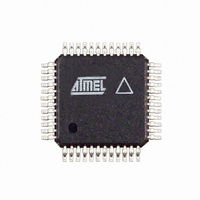AT86RF211DAI-R Atmel, AT86RF211DAI-R Datasheet - Page 10

AT86RF211DAI-R
Manufacturer Part Number
AT86RF211DAI-R
Description
IC TXRX FR FSK 400-950MHZ 48-TQF
Manufacturer
Atmel
Datasheet
1.AT86RF211DAI-R.pdf
(48 pages)
Specifications of AT86RF211DAI-R
Frequency
400MHz ~ 950MHz
Data Rate - Maximum
100kbps
Modulation Or Protocol
FSK
Applications
ISM
Power - Output
7dBm ~ 12dBm
Sensitivity
-107dBm
Voltage - Supply
2.4 V ~ 3.6 V
Data Interface
PCB, Surface Mount
Antenna Connector
PCB, Surface Mount
Operating Temperature
-40°C ~ 85°C
Package / Case
48-TQFP Exposed Pad, 48-eTQFP, 48-HTQFP, 48-VQFP
Lead Free Status / RoHS Status
Contains lead / RoHS non-compliant
Memory Size
-
Current - Transmitting
-
Current - Receiving
-
Overview and Choice of
Intermediate Frequencies
Rx - Tx Switch
Image Rejection and RF Filter
Figure 9. Typical 50 SAW Filter Implementation in the 868 MHz Band
10
AT86RF211
SWOUT (pin 48)
SPST Switch
For selectivity and flexibility purpose, a classical and robust 2 IF superheterodyne archi-
tecture has been selected for the AT86RF211. In order to minimize the external
components cost, the most popular IF values have been chosen. The impedances of the
input/output of the mixing stages have been internally matched to the most usual
ceramic filter impedances.
Two typical IF values are suggested:
•
•
A SPST switch is integrated. In the transmission mode, it protects the LNA input from
the large voltage swings of the PA output (up to several volts peak-to-peak), which is
switched to a high impedance state. It is automatically turned ON or OFF by the RX/TX
control bit. The insertion loss is about 2 dB and the reverse isolation about 30 dB in a
300
The immunity of the AT86RF211 can be improved with an external band-pass filter.
For example, when using a SAW Filter, this device must be matched with the LNA input
and the switch output. The following scheme gives the typical implementation for an
868 MHz application with a 50 /50 SAW filter.
See Table 2 for precise matching information.
The SAW filter can be replaced by a TEM ceramic, helicoidal or a ceramic coax /4 res-
onator designed as a narrow band-pass filter. For instance, with an IF selected at
10.7 MHz, a -3 dB bandwidth of 5 MHz, with an insertion loss of 1 dB and an image
rejection of 12 dB can be achieved with the following:
10.7 MHz is the most popular option.
21.4 MHz: the image frequency is far enough from the carrier frequency to enable
the use of a front-end ceramic filter instead of a SAW filter. It is also noticeable that
21.4 MHz quartz filters usually have more abrupt slopes than 10.7 MHz ceramic
filters.
2.2 nH
environment.
These inductors can be printed
SAW
50Ω
12 nH
(pin 45)
RXIN
1942C–WIRE–06/02














